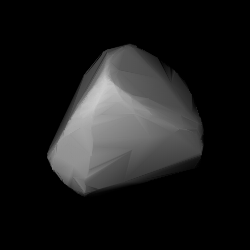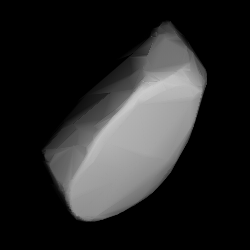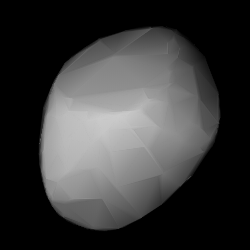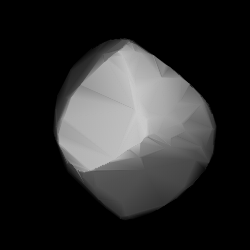913 Otila is a bright Flora asteroid from the inner regions of the asteroid belt. It was discovered by German astronomer Karl Reinmuth at the Heidelberg Observatory on 19 May 1919. The stony S-type asteroid has a short rotation period of 4.9 hours and measures approximately 12 kilometers in diameter. It was named after a common German female name unrelated to the discoverer's contemporaries, that was taken from the almanac Lahrer Hinkender Bote.
924 Toni is a large background asteroid, approximately 80 kilometers in diameter, from the outer regions of the asteroid belt. It was discovered on 20 October 1919, by German astronomer Karl Reinmuth at the Heidelberg-Königstuhl State Observatory. The X-type asteroid has a rotation period of 19.4 hours. It was named "Toni", a common German female name unrelated to the discoverer's contemporaries, that was taken from the almanac Lahrer Hinkender Bote.
942 Romilda is a background asteroid, approximately 36 kilometers in diameter, located in the outer region of the asteroid belt. It was discovered by German astronomer Karl Reinmuth at the Heidelberg Observatory on 11 October 1920. The assumed C-type asteroid has a rotation period of 6.97 hours. It was named "Romilda", a common German female name unrelated to the discoverer's contemporaries, that was taken from the almanac Lahrer Hinkender Bote.

950 Ahrensa, provisional designation 1921 JP, is a stony Phocaea asteroid and slow rotator from the inner regions of the asteroid belt, approximately 15 kilometers in diameter. It was discovered on 1 April 1921, by German astronomer Karl Reinmuth at Heidelberg Observatory in southern Germany.
974 Lioba is a stony background asteroid from the central regions of the asteroid belt, approximately 25 kilometers in diameter. It was discovered on 18 March 1922, by astronomer Karl Reinmuth at the Heidelberg-Königstuhl State Observatory in southern Germany. The S-type asteroid has a longer than average rotation period of 38.7 hours. It was named after missionary Saint Leoba (Lioba).

934 Thüringia is a dark background asteroid, approximately 54 kilometers in diameter, located in the central region of the asteroid belt. It was discovered on 15 August 1920, by astronomer Walter Baade at the Bergedorf Observatory in Hamburg, Germany. The hydrated C-type asteroid has a rotation period of 8.2 hours and is likely irregular in shape. It was named after the German state of Thuringia. The naming was inspired by the ocean liner SS Thuringia.
1018 Arnolda, provisional designation 1924 QM, is a stony asteroid from the central regions of the asteroid belt, approximately 16 kilometers in diameter. It was discovered on 3 March 1924, by German astronomer Karl Reinmuth at the Heidelberg-Königstuhl State Observatory in southwest Germany. The asteroid was named after physicist Arnold Berliner.

1219 Britta, provisional designation 1932 CJ, is a stony background asteroid from the inner regions of the asteroid belt, approximately 11 kilometers in diameter. It was discovered on 6 February 1932, by German astronomer Max Wolf at the Heidelberg-Königstuhl State Observatory in southern Germany. The likely elongated S-type asteroid has a rotation period of 5.57 hours. Any reference of its name to a person is unknown.
1057 Wanda, provisional designation 1925 QB, is a carbonaceous background asteroid from the outer region of the asteroid belt, approximately 43 kilometers in diameter. It was discovered by Grigory Shajn at the Simeiz Observatory in 1925, and later named after Polish–Soviet writer Wanda Wasilewska. The asteroid has a rotation period of 28.8 hours.
1063 Aquilegia, provisional designation 1925 XA, is a background asteroid from the inner regions of the asteroid belt, approximately 17 kilometers in diameter. It was discovered on 6 December 1925, by German astronomer Karl Reinmuth at the Heidelberg Observatory in southwest Germany. The asteroid was named after the flowering plant Aquilegia (columbine).

1087 Arabis is a stony Eoan asteroid from the outer regions of the asteroid belt, approximately 35 kilometers in diameter. It was iscovered by Karl Reinmuth at the Heidelberg Observatory in 1927 and assigned the provisional designation 1927 RD. The asteroid was named after the flowering plant Arabis (rockcress).
1092 Lilium, provisional designation 1924 PN, is a dark, carbonaceous background asteroid from the outer regions of the asteroid belt, approximately 44 kilometers in diameter. It was discovered on 12 January 1924, by German astronomer Karl Reinmuth at the Heidelberg Observatory in southwest Germany. The asteroid was named after the flower Lilium.

1107 Lictoria is a large Hygiea asteroid, approximately 79 kilometers in diameter, from the outer regions of the asteroid belt. It was discovered by Luigi Volta at the Pino Torinese Observatory in 1929, and named after the Fasces Lictores, Latin for "Fasci Littori", the symbol of the Italian fascist party.
1144 Oda, provisional designation 1930 BJ, is a dark Hildian asteroid from the outermost regions of the asteroid belt, approximately 57 kilometers in diameter. It was discovered on 28 January 1930, by German astronomer Karl Reinmuth at the Heidelberg-Königstuhl State Observatory. The asteroid's name is a German female name, not related to the discoverer's contemporaries.

1404 Ajax is a carbonaceous Jupiter trojan from the Greek camp, approximately 83 kilometers kilometers in diameter. It was discovered on 17 August 1936, by German astronomer Karl Reinmuth at Heidelberg Observatory in southern Germany, and named after the legendary warrior Ajax from Greek mythology. The assumed C-type asteroid belongs to the 40 largest Jupiter trojans and has a longer than average rotation period of 29.4 hours.
1609 Brenda, provisional designation 1951 NL, is a stony asteroid from the central region of the asteroid belt, approximately 28 kilometers in diameter. It was discovered on 10 July 1951, by South African astronomer Ernest Johnson at the Johannesburg Observatory in South Africa, and named after his granddaughter, Brenda.
1234 Elyna, provisional designation 1931 UF, is an Eoan asteroid from the outer regions of the asteroid belt, approximately 25 kilometers in diameter. It was discovered on 18 October 1931, by astronomer Karl Reinmuth at the Heidelberg-Königstuhl State Observatory. The asteroid was named after the flowering plant Elyna.

1188 Gothlandia, provisional designation 1930 SB, is a stony Florian asteroid from the inner regions of the asteroid belt, approximately 12 kilometers in diameter. Discovered by astronomer Josep Comas i Solà at the Fabra Observatory in 1930, the asteroid was later named after the ancient name of the Spanish autonomous community of Catalonia.

1825 Klare is a background asteroid from the central region of the asteroid belt, approximately 15 kilometers in diameter. It was discovered on 31 August 1954, by German astronomer Karl Reinmuth at Heidelberg Observatory in southern Germany. The asteroid was named after Heidelberg astronomer Gerhard Klare.
1284 Latvia, provisional designation 1933 OP, is a rare-type asteroid from the middle region of the asteroid belt, approximately 37 kilometers in diameter. It was discovered on 27 July 1933, by German astronomer Karl Reinmuth at Heidelberg Observatory in southern Germany, and named after the Republic of Latvia.









